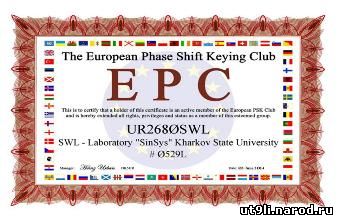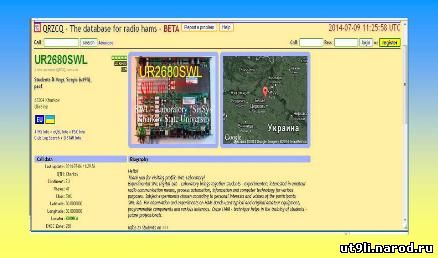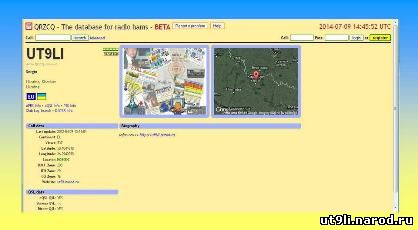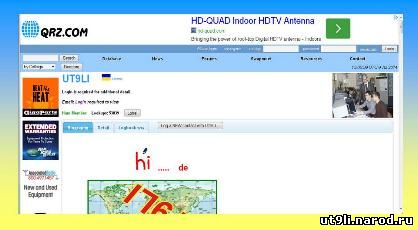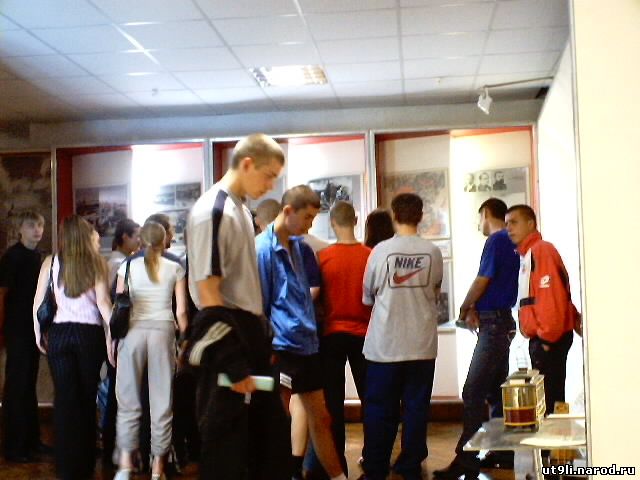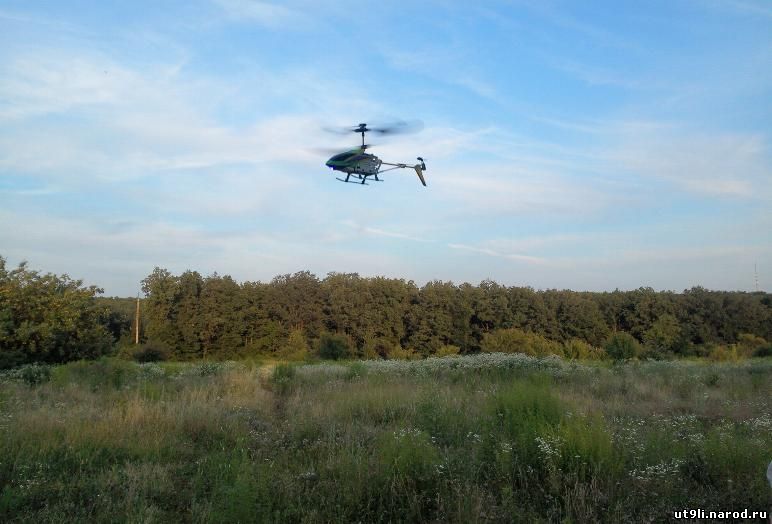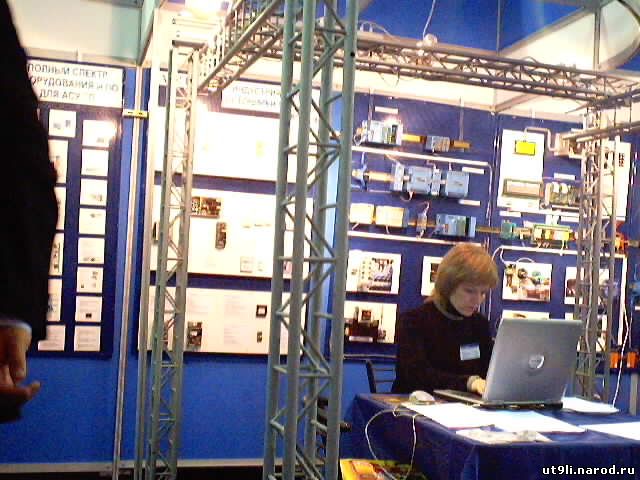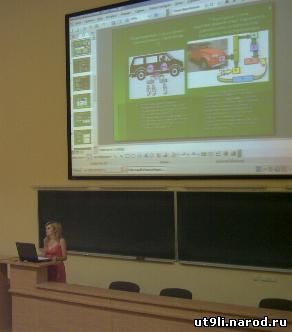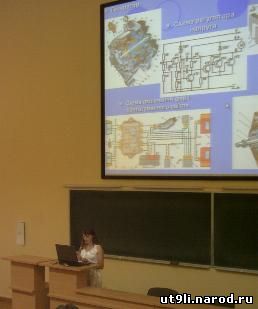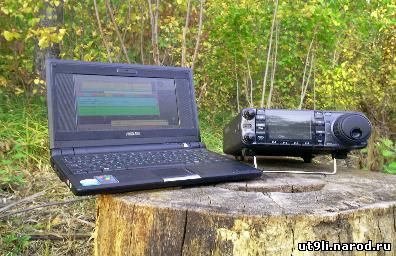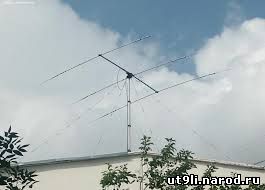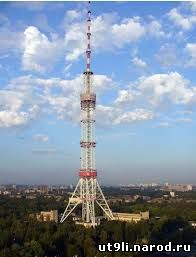EXPERIMENTS, advice and answers 
(Shems to Student-Page)
( 1)? * How to Hear the HF amateur radio? ---------------
1)? * How to Hear the HF amateur radio? ---------------
Hams allocated land HF band:
160-meter (1.81 - 2 MHz)
80-meter-high (3.5 - 3.8 MHz)
40-meter (7 - 7.1 MHz)
30-meter (only Telegraph - CW - 10.1 - 10.15 MHz)
20-meter (14 - 14.35 MHz)
16-meter (18,068 - 18,318 MHz)
15-meter (21 - 21.45 MHz)
12-meter (24.89 - 25.14 MHz)
10-meter (28 - 29.7 MHz).
The easiest and cheapest way -
Use the two household radios having shortwave, e.g., 3 ... 4 MHz; 7 ... 8 MHz or more. RX / receivers and next:
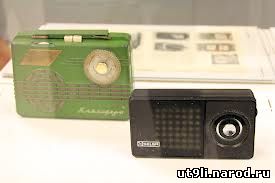 <<< Adjust the first approximately 3.5 MHz,
<<< Adjust the first approximately 3.5 MHz,
and second knob - slowly rotate near 3.5 MHz >>> 
"Softly" by changing the setting of the second receiver in the dynamics of the appearance of the first you hear the carrier signal, which depends on the position of the second knob RX / receiver. If the first receiver you manage to hear amateur radio SSB-(3.6 or 7,1 MHz) - during the evening hours of work a lot, you will find that it is unintelligible correspondent-distorted. Start carefully adjust the carrier already known from the second receiver received on correspondent. At some point find that manifest voice correspondent, it will be legible and qualitative modulation (usually pleasant voice frequency spectrum without distortion). This is a condition when you managed to restore carrying amateur radio with single sideband SSB - modulation. Experimenting so you will be able to listen to different radio stations in volume, not only working phone, but the telegraph. Proposed simplest way to allow for a first observation, simple experiments with different radios, antennas and find qualitative differences in the preparation of such a "combined" radio receiver from different radio receivers. Very soon you will find yourself modest advantages and disadvantages of large sets used. Most importantly - you first hear radio amateurs operating in the air, and discover a desire to continue to do this radio hobby, but much more serious on the technical side .....
It also provided our first experiment.
( 2)? * Can a student make a simple HF radio? ------------
2)? * Can a student make a simple HF radio? ------------
Interested in technology, students often can not afford significant financial expenditure for the purchase of branded radio, but because on the way to realize their desire professionalism through improvised technology. Improvised sophisticated device may also have scarce or difficult for independent manufacture the necessary components, but because all these little things are often the main cause of cardiac activity in the beginning of the path to the realization of the first technical dreams or ideas. Despite this, many seasoned radio and other hobby-lovers know that, after the first good luck always be a desire to continue begun. Therefore, when he first heard the work of HF radio amateurs, really want to quickly get a "low-cost", but his radio. How to solve this problem, if time and so all is not enough, and yet engaged in designing experience or knowledge?
*) Satisfactory for starting characteristics can be obtained using a superheterodyne radio past years VEF-201, 202, Okean, Spidola or other similar RX with an additional CW-oscillator after a simple adjustment of inductance in comfortable designs of rotary switch ranges.
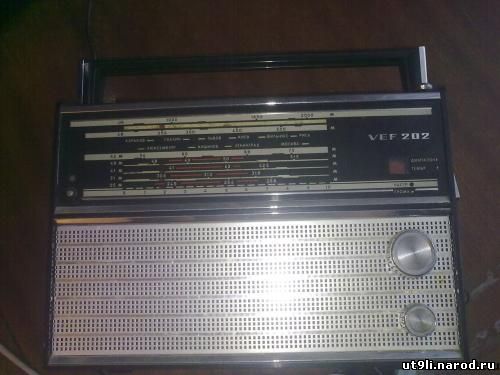
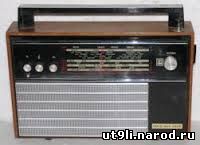
*) Modern radios based on universal chips are commercially available and implemented at home is quite simple. Unfortunately, for use in this HAM - direction, they are not very suitable and differ markedly worse performance. Therefore remains the preferred purchase and modify an old radio on the radio market price which is often symbolic and accessible. Suggested old radios comfortable design that is easy to rearrange them in wide-band circuit known to amateur bands, native vernier device settings are quite suitable for carefully listening to narrow spaces HF - band, and within the scope of the housing there is always a place to put their hands collected additional block (telegraph CW-GENERATOR or CWG et al.)
(![]() 3)? * HOW TO APPLY telegraph heterodyne? ------------
3)? * HOW TO APPLY telegraph heterodyne? ------------
Telegraph circuit oscillator (CW) can be easily found in various libraries schemes. The simplest way, suitable for experiments if they have the body of oscillation frequency adjustment CW (variable capacitor or inductor core inside):
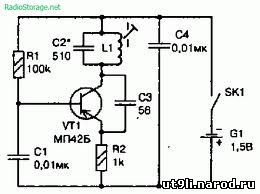
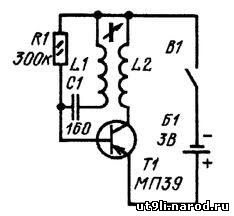
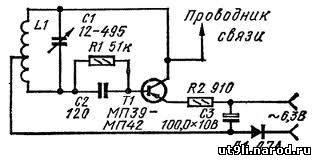
If used with CW-mode radio RX VEF, the frequency generation must comply with the intermediate frequency (IF) circuit, for example, 465 kHz. In other RX IF receivers may vary (433, 215 kHz, ...). A simple compact one transistor generator located inside the radio and almost always needs to implement the communication line through a capacitor or inductor with a few turns of the IF amplifier circuit because its capacity is enough to carry out their prescribed functions. CW-Generator (CWG) adjustment after installation is always required to "get" SIGNAL at the IF frequency. Finally, it is necessary to provide for the CWG, switch because it is necessary only to receive CW / SSB - radio stations.
(![]() 4)? * Are there still an easier solution? ------------
4)? * Are there still an easier solution? ------------
The question is quite appropriate, because advanced manufacturing technology of radio elements presented designers of wireless devices previously unknown innovative technical problem solving. Said, it becomes clear after meeting with schemes for logic elements. We now turn to the details.
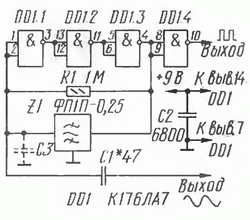 <<<=This Schema Illustrates one example of a generator for applying an analog or logic chip. This tiny device has a high stability frequency generation and the construction itself will not contain an oscillating circuit with trimmer. Obviously, such a decision may be more attractive and the developer will only require the selection of the capacitor determines the frequency generating CWG. In the literature and other sources of real practical scheme may not be able to find, but the construction is not time consuming.
<<<=This Schema Illustrates one example of a generator for applying an analog or logic chip. This tiny device has a high stability frequency generation and the construction itself will not contain an oscillating circuit with trimmer. Obviously, such a decision may be more attractive and the developer will only require the selection of the capacitor determines the frequency generating CWG. In the literature and other sources of real practical scheme may not be able to find, but the construction is not time consuming.
(![]() 5)? * WHERE AND HOW TO OBTAIN A LICENSE OBSERVER SWL? ------------
5)? * WHERE AND HOW TO OBTAIN A LICENSE OBSERVER SWL? ------------
Observation skills are constantly improved and so I want to become a real observer - SWL. Students, especially from other cities, how to obtain individual or collective SWL-license as before, and are now allowed in the regional association of radio amateurs (location, where easy to find on the Internet), as well as similar international, who also traded over the Internet, reading the relevant provisions on their sites >>>
EPCUkraine <<<- refer to the section "Registering ..."
30 MDG <<<- enter through the button "Join 30MDG"
(![]() 6)? * Which antenna APPLY AT HOME? ------------
6)? * Which antenna APPLY AT HOME? ------------
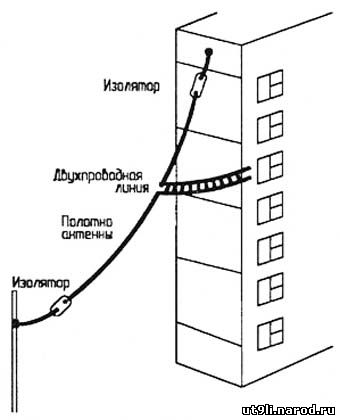
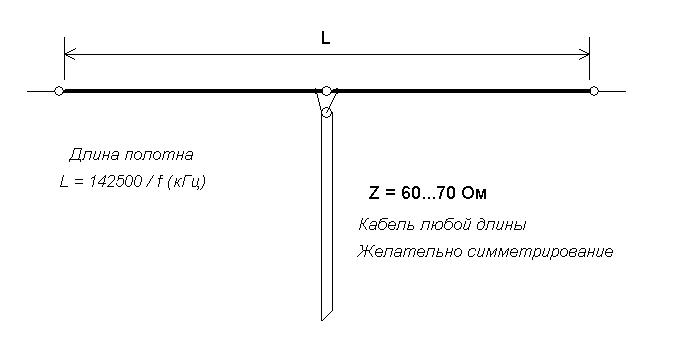
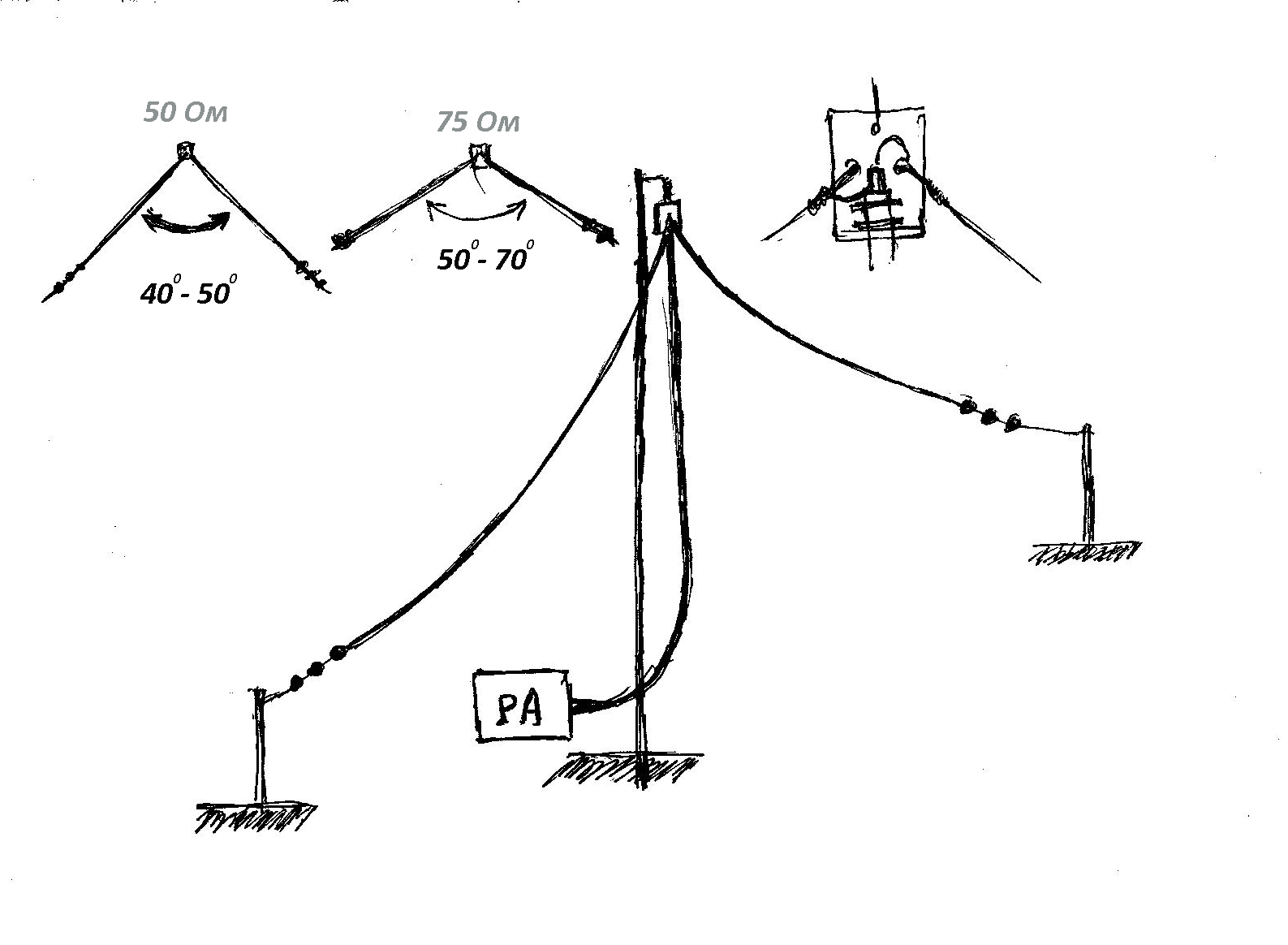
At home, as they say, not very overclocking with the original design of the antenna, but most of them can be proven to consider dipoles with links executed coaxial cable 50 or 75 ohm matching and balun. Calculating the size of the antenna elements in a matter of seconds now easily be performed by a computer program MMANA-071E. Novice hams best to start his practice is with such antennas, whose designs are clear, simple in implementation and allow them to experiment with using known or own matching devices.
(![]() 6)? * How to make a "RX"-receiver PC-based laptops ..? ------------
6)? * How to make a "RX"-receiver PC-based laptops ..? ------------
This question always arises from advanced students who are interested in ham radio "HAM - diversions" of different orientation. Yes, the above examples - is an attempt to learn the first to hear "HAMs" and interested in this hobby application direction. Soldering, development schemes and other emergency in the hobby may come later, but for now I would like to adjust your <MY RX computer> for a particular purpose. And I must say, this goal is feasible, if only because that similar devices are known for receiving FM / TV stations and others already have. But to listen to "HAM" will have to make an additional device itself. Better to start with a simple set-top boxes, to understand and get the result soon move on to more complex technical solution.
Having already had a homemade antenna (VS1AA, GP, LW, IV, W3DZZ and others already known), connect it to the oscillation circuit - turns 30 with taps 10 and 20 turn trimmer with hand grounded
capacitor C1 to 5 .. 300 pF .![]() This is our simplest selector signals from a wide range radio frequency. Followed to collect high-impedance RF amplifier. It is convenient apply the radio tube, for example "6Ж2П"
This is our simplest selector signals from a wide range radio frequency. Followed to collect high-impedance RF amplifier. It is convenient apply the radio tube, for example "6Ж2П" 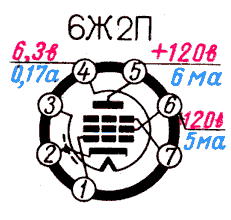 or other, "converted" in triode.
or other, "converted" in triode. 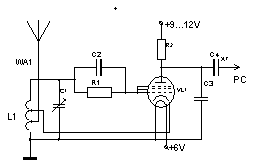 This simple device made with their own hands (R1 = 12K; C2 = 68p; R2 = 1,8 K; C3 = 10n; C4 = 100n) and will be our RX-prefix. Connecting it to the line input of the PC sound card, can hope to hear AM - HF radio range. But to get real results, we solve the problem have to use special software SDRadio
This simple device made with their own hands (R1 = 12K; C2 = 68p; R2 = 1,8 K; C3 = 10n; C4 = 100n) and will be our RX-prefix. Connecting it to the line input of the PC sound card, can hope to hear AM - HF radio range. But to get real results, we solve the problem have to use special software SDRadio 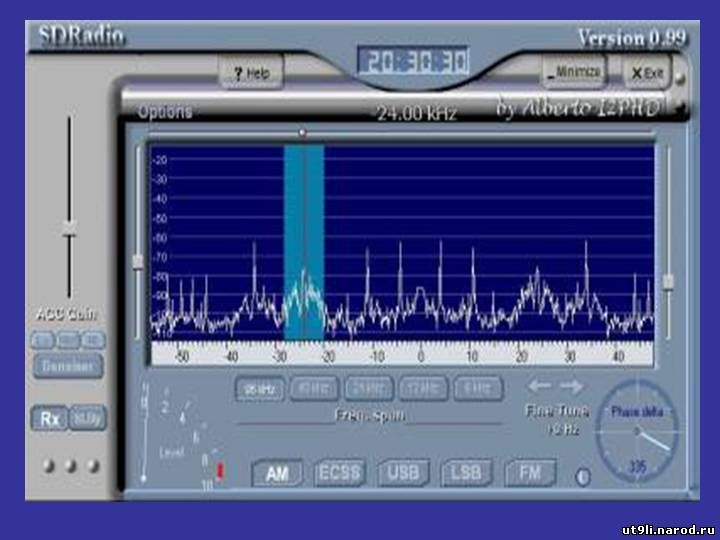 After installing the software on a PC it is time to conduct experiments. Should start with the development of the program, select "AM", for which established and simple RX-console. Many nuances of the upcoming experiments can be found in the reviews on forums with relevant thematic direction. May be able to discover something new with their own experiments - will share the results with colleagues in the INET-available networks. While bring some results of our experiments.
After installing the software on a PC it is time to conduct experiments. Should start with the development of the program, select "AM", for which established and simple RX-console. Many nuances of the upcoming experiments can be found in the reviews on forums with relevant thematic direction. May be able to discover something new with their own experiments - will share the results with colleagues in the INET-available networks. While bring some results of our experiments.
REM-conclusion: Students have heard and read a lot of words about the forest tube amplifiers and bass because it was on the lamp was selected first design our RX Extender to your computer. 1. In the experiments it was found that without a good antenna on your computer to hear at least some radio proved to be problematic. 2. Who was more successful convinced that the reception quality is very dependent on low-frequency amplifier and computer selection program settings SDRadio. 3. Everyone who experienced the scheme concluded that it is not the radio, but only its simplest model, but a real, living and active. Therefore, further experiments will be aimed at improving the RX-console.
Instead of lamp options RX-prefix, which was deliberately selected to the experimenter was able to touch the art of past years, still remains the preferred scheme to collect and conduct experiments on board with transistors. In transistor RX easier to understand the processes and the influence of parameters on the quality of the various components of the device. The following scheme has been developed by students and proved to be convenient for the study of SDR. The device is assembled on two transistors (HF transistors either but one conductivity). The circuit is a regenerative receiver direct amplification, which can be converted into super-regenerative mode. By carefully adjusting (provided for in the scheme variable resistors) is realized super-regenerative mode in which the device is designed to have the same sensitivity as complicated superheterodyne radio. Therefore, this solution is more geared to experiment even with room simple antennas (telescope long wire). Coil L2 band oscillation circuit has 30 turns and is wound on a frame, preferably with adjustable ferrite core. Coil L1 is located on the frame with L2 and has 3-4 turns. Output signal PC, as well as in the lamp version, connected to the input of the computer where you installed the program known SDRadio. Experiments with the developed device proved more successful, and the results are obvious. The device has a small footprint, is working with the antenna - a piece of wire and is operational at the power supply voltage is less than 2.2 V.
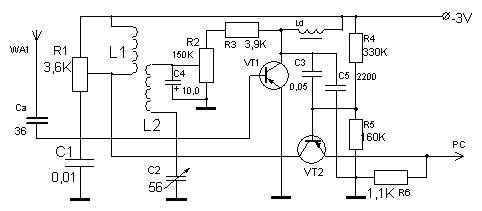 AМ-signal in SDRadio >
AМ-signal in SDRadio > 
REM-conclusion: 1. Super-regenerative mode is achieved with careful tuning. 2. With a large signal level of the stations difficult to make other stations with lower signal levels. 3. Selectivity reception is very dependent on the settings of the receiver. 4. Generally, the device is operable and is useful for various experiments.
***) These examples are interesting for the first experiments, but the device did not include radio reception with CW-SSB-mode. Managed to make the examples that many functions of classical receiver can now perform a special computer program. When using technology software-defined radio (SDR) virtually all of the work of processing and demodulating the radio signal is passed on to the software. Using the software algorithms may be implemented such functions which are very difficult to obtain at the analog processing. In the ideal SDR receiver the received signal from the antenna through the band pass filter is supplied to a fast analog-to-digital converter (ADC) that digitizes the entire control range of the spectrum. The digitized signal is transmitted to the computer, but it requires considerable computing power of the PC for processing the binary information in real time, which make up a programmable logic chips - FPGA for preprocessing. Carving of the entire spectrum of land required width achieved the task set in the further processing of the desired signal. Hardware it runs without known GPA. Side channels are excluded from receiving the specified dynamic range, determined by the bit ADC. This verbal simplicity technically requires scarce and expensive elements (Radio-items). Devices based on highly integrated chips with hundreds of pins (>200) are not very easy to implement on the board at home. FPGA chip is not easy to program, and because we can just say that this attractive technique remains the lot of professionals with the appropriate equipment.
Currently hams implement SDR only at low frequencies with ADC and DAC, using the properties of the PC sound card. To transfer spectrum RF signals at lower intermediate frequency used direct conversion. As a result of SDR receiver is able to receive and demodulate all modes CW, SSB, AM, FM and DIGITAL. SDR program always
have a panoramic spectrum analyzer, without which it would be difficult to use the RF Extender. SDR block can be written as >> 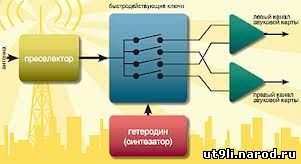 SDR in parts and components >>
SDR in parts and components >> 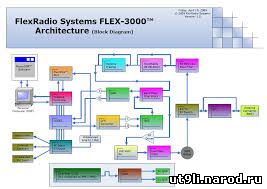 always more accurate and closer captures the essence of the device. Well, in the SDR boards speaks for itself even in the photo >>
always more accurate and closer captures the essence of the device. Well, in the SDR boards speaks for itself even in the photo >> 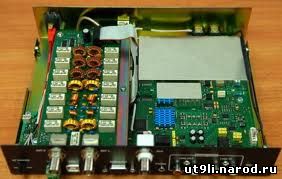 BUT, despite the complexity of the experiments can be extended with a not very complicated SDR, for which all the components can be purchased through a network Inet. The results of the self-made SDR at the initial stage of development of this technique will be quite satisfactory. For our experiments with SWL signals CW / SSB will be acceptable the SDR - THREE chips. In this radio receiving RX - top box using one crystal oscillator 36 MHz, and the change is performed by switching ranges of fixed capacitors. Many details, the understanding of which is mandatory and necessary, can be found on web pages because this technique is discussed in detail in the Forums - assemblies, components, technologically implemented elements.
BUT, despite the complexity of the experiments can be extended with a not very complicated SDR, for which all the components can be purchased through a network Inet. The results of the self-made SDR at the initial stage of development of this technique will be quite satisfactory. For our experiments with SWL signals CW / SSB will be acceptable the SDR - THREE chips. In this radio receiving RX - top box using one crystal oscillator 36 MHz, and the change is performed by switching ranges of fixed capacitors. Many details, the understanding of which is mandatory and necessary, can be found on web pages because this technique is discussed in detail in the Forums - assemblies, components, technologically implemented elements. 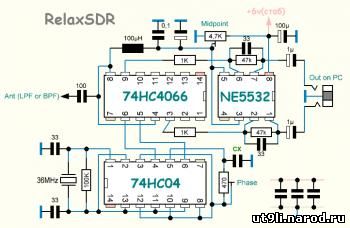
After the implementation of all the experiments with this device were successful and attractive. Despite the simplicity of the scheme, the device is almost required to master the techniques of its settings. PC console itself has no elements of setting and action of the operator to monitor the radio interface available with the famous program SDRadio, installed on your computer.
REM-conclusion: 1. In the available sources are not considered many of the subtleties setting schemes that have to learn yourself. 2. Choices range capacitors Cx are required only after when the scheme becomes operational.
*** All those who successfully completed a practical acquaintance with the radio receiving means convinced that pretty much mastered the application questions, the answers to which can not be found in any literature and hear the lectures, which are limited in time and the majority in the audience to perceive such questions are not inclined. Therefore personal application will certainly help achieve soon learn the technique of communication, navigation, information technology and many other areas for future engineering. As for the amateur SDR for SQL practice, the most appropriate option can be considered through the acquisition of INET ready-made kits for self-assembly devices with good technical parameters. In respect of such devices can be found a lot of feedback from users and which should start before the design your practice. In SQL - laboratory can meet with ready-made solutions that are practical illustrations considered art, but in any case their pinnacle of perfection. Technical tops SDR is all depend on your computer. It should always be remembered. "Weakness" of the computer will not yield the desired results on the console SDR even the "cool" set for its implementation. 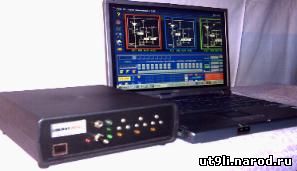
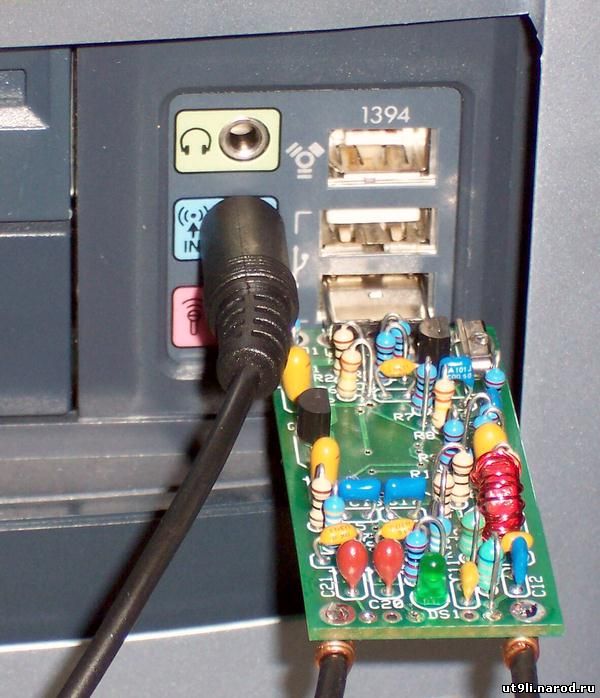 This is a very important factor in all of the successful implementation of the first discovered after Your FIRST _ SDR and have already made the relevant findings to improve SDR continue to engage with the original circuitry of analog- and digital- Receivers (RX).
This is a very important factor in all of the successful implementation of the first discovered after Your FIRST _ SDR and have already made the relevant findings to improve SDR continue to engage with the original circuitry of analog- and digital- Receivers (RX).
COMPARISON OF POPULAR use ANTENNAS
(someone else's experience can be useful when choosing the design of the antenna)
Known and popular Inverted V - its manufacture >>>
For those who like to take a double conversion receiver DEGEN
... You can listen to and hear the comments of the user >>>
INTRODUCING MAGNETIC antenna loop
Your dish probably require the same accommodation >>
* ) Useful information for amateur radio operators on many issues under consideration and discuss publish themselves online HAM - amateurs>>> ![]()
Results of reciprocal visits to sites, conducted SWL & QSO automatically displayed on a globe or Kerte >>>
BACK (on Digital Mode-Page) >>> 
BACK TO HOME PAGE (on Start-Page) >>> ![]()
